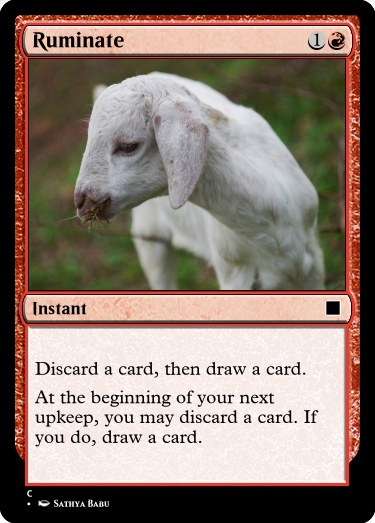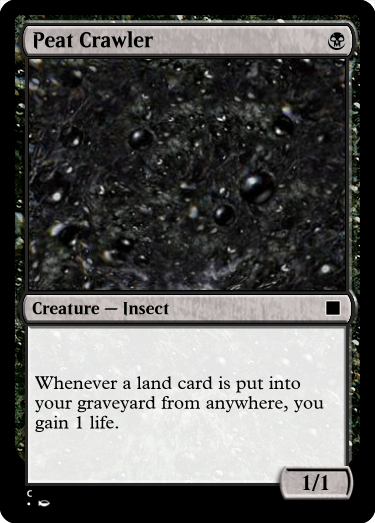Originally posted on Cohost, archived in October 2024.
We're continuing Worlds Without Number's region generation process for high-level details of our setting. Last time we placed major terrain and landmarks, this time we'll build nations using a bit of randomly generated history.
Here I've had to modify the WWN approach a bit. In particular, I'm skipping any detailed mapping the book calls for (drawing rivers, etc). I'm also a bit constrained - as we discussed last time, Magic really does ask for a certain correspondence between terrain and social flavor. So I've massaged the process a little bit to make sure the flavor of our nations matches their physical geography.
National Borders
To start, we need to split our regional map into various nations / polities are located. To avoid our working map just being a jumble of text, I'll start by replacing the terrain labels with a color palette. Since the last post, I've also decided the mountain range should cut off the western part of the map from the north:

This helps answer an important question: what separates this region from the rest of the world? In our case, the mountains and the desert provide natural borders to the north and east, complementing the ocean to the west and south. It also works towards some plans I have for the red/green color pair; more on that later.
Next we need to add national borders. WWN recommends about six nations per region, so I've worked out the following map:

These names are temporary for this post. In subsequent posts I'll be working out the specifics of each nation, including actual names.
History Generation
Each nation receives two random historical events, which often imply connections to other nations. Rather than generate a pair of events for each nation individually, I decided to roll all six pairs at once. This gave me a little more flexibility to make sure each nation fit in with the Magic color identity of its area.
An Aside About Swamps
In Magic, the color black has a dimension beyond either the social or the ecological - while black represents individualist pursuit of power by any means, it's also poison, corruption, and demons, capital-E fantasy Evil. That gets aligned with the land type of swamps in a move that sits uneasily with me, working on a certain conception of a swamp as a location of corruption, death, and danger. This poses a problem: Magic needs swamps, and it needs them to support black's flavor, but as a designer I don't like resting on tired stereotypes about a real-life ecology. Trying to solve this ended up creating the core setting detail of this work, starting from our first national history:
Blackred Mountain
Tags:
- Twist of Fate: Roll again; if the event was positive twist it to ultimately be a negative to the group, and vice-versa.
- Great Infrastructure: Some tremendous work of infrastructure was accomplished: canals, vast walls, roads, aqueducts, mines, or the like. (twisted to negative)
- Depravity: Vile debauches, unclean habits, and base hungers became commonplace among the group.
This was a huge undergrown mining and trade city built into an entire mountain. During a war with Swamp Nation, for unknown reasons an unnatural black fluid flooded Blackred Mountain and spilled outward. Denizens of the city were twisted by contact with the fluid, and their monstrous descendants are still present with unknown goals or social structure. Blackred Mountain has not engaged in diplomacy or trade since, and consistently lethal scouting missions have led other factions to avoid the area.
Swamp Nation
Tags:
- External War: The group faced a war with some external enemy or rival nation, with grave consequences.
- Brutal Oppression: Some portion of the group was reduced to a state of wretched subservience by the rest.
The swamp area used to be a regular marshland with several major cities and many smaller settlements, forming Swamp Nation. After the war with Blackred Mountain, corruption spilled into the swamp, making endemic life more alien and hostile, poisoning the land, and causing the buildings sink into the swamp. One city survived within Swamp Nation's borders, surrounded by ancient hyper-optimized farmland which resisted the vile changes. This city has developed a firmly rooted power structure and a massive underclass descended from wave after wave of refugees as the nation's other cities collapsed.
Savanna Nation
Tags:
- Freakish Magic: A particular type of magic was developed here that is unknown elsewhere, and its practitioners keep its secrets well.
- Class Struggle: Different classes were in conflict, either subtle or overt, all seeking their own gain.
This group once lived in the megaplex ruins in the desert, either as its original builders or later inheritors. They for the savanna after an ancient catastrophe, but they brought with them a secret form of magic. Unlike Caldera City spellcraft, this magic directly augments people (specifics TBD based on where we land on green/white mechanics). Until recently, this art was used to support a small ruling class's dominance over the majority of the population. In living memory, there was an organized revolution from the Savanna Nation underclass, resulting in a much more egalitarian, community-based social structure.
Mountain Nation
Tags:
- Religious Rise: A powerful new religion arose among the group.
- Consequences: Pick an event of a prior age; it had long-term consequences that were good, for a bad event, or bad, for a good event.
This is a loose affiliation of groups living in the mountains and foothills, traditionally herders. They tend to follow good weather and good grazing, and they all claim a shared past after fleeing a grim event (possibly the same that caused Savanna Nation to leave the megaplex). A strong religious tradition began with that exodus and binds this people together. After the Blackred Mountain incident, overland trade was rerouted northward through Mountain Nation land. With so much wealth flowing through the mountains, herding has been supplemented with highway robbery - a reasonable tithe to the Mountain Nation peoples.
Caldera City
Tags:
- Magical Tech: The group developed a useful and widespread magical tech or infrastructure that may have survived into the present.
- Diplomatic Coup: The group achieved an extremely successful alliance or affiliation with a neighboring group that may yet persist.
One of the oldest institutions in the region is the college of spellcraft in Caldera City. The arts taught there protect the city directly, and also confer enough wealth and prestige to solve most problems of diplomacy. While the City publicly denounces banditry in the mountains, practically they enjoy a mutually beneficial relationship with Mountain Nation. City caravans always carry a generous "tribute" for any unexpected stops, and Mountain Nation ensures that outsiders bent on less gentle robbery schemes are promptly put out of business.
Jungle Nation
Tags:
- Rare Resource: A uniquely valuable resource was found or manufactured by the group, which used or traded it to full effect.
- Exquisite Art: The group produced art that is revered to this day, either in general or in a specific medium or form of literature.
Jungle Nation nominally controls the full breadth of the thick rainforest, but in practice most people and power are situated along a major river system, connected to outside trade through a mouth at the western ocean. These rivers serve as primary transportation, avoiding the thick undergrowth in the forest or the beast-filled hills in the north and east. The jungle is home to a unique type of tree whose fibrous bark can be woven into textiles, and its cultivation, processing, and export drives Jungle Nation's economy. The most skilled arborists maintain trees selectively bred for color, allowing the creation of complex woven patterns without any dye or pigment. These are prized as fine attire throughout the region.
Non-National Elements
Each of the six nations above roughly corresponds to a Magic color pair. For three of the remaining four pairs, there are non-political processes:
- At the border of the swamp and the jungle, the process of seeping poison moves upward, weakening the land and transforming the endemic jungle ecosystem (black/green)
- On the coast of the swamp, the same corruption spills into the ocean, where more and more ships go missing and strange monsters are seen in the depths (blue/black)
- In the hills surrounding the jungle, there have always been large, territorial beasts. Some people eke out a living in small villages, others travel from afar to hunt (red/green)
A Trade Guild
While overland trade occurs, it seems that much of the region is more easily traversed by sea, or by air. A guild of sailing and flying merchants, with potentially complex internal politics but a clean bureaucratic exterior, fits the remaining color pair of white/blue well, and provides an additional entity for the various factions to have interactions with and orientations to. I'll likely use WWN's "Court" procedures to roll up more complex information about this guild in a subsequent post.
Looking Forward
I think that wraps up the region-level worldbuilding for now. The next few posts I make will probably be more focused on mechanics as I start to lock in themes and archetypes for the set, then we'll return to worldbuilding to drill into each faction in detail.





















